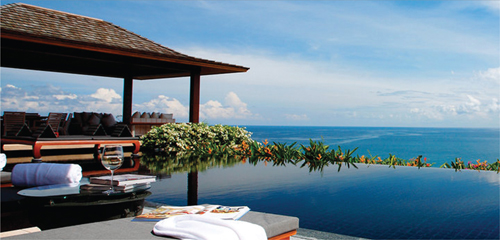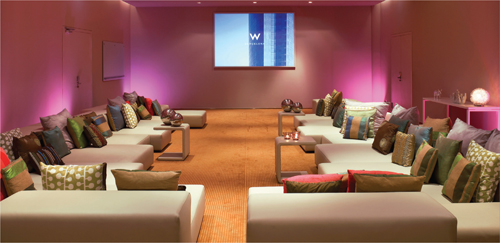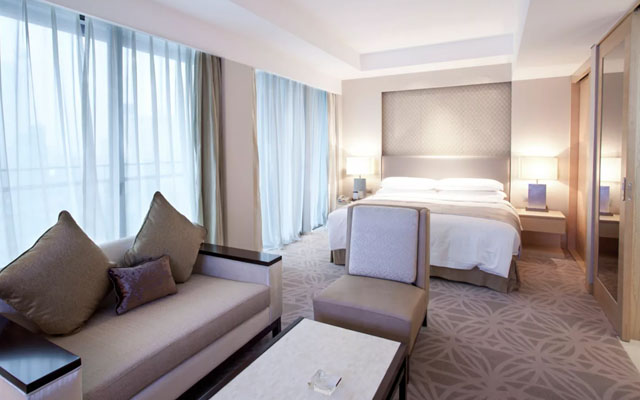It isn’t just creative, independent hotel developers who are conjuring up pretty properties. Some mega hotel companies have also joined in, courting business travellers and event planners with their own design-led or boutique brands. Karen Yue speaks to Lindsey Ueberroth, president of Preferred Hotel Group, and George Fleck, director, global brand management of W Hotels & Le Meridien

Andara Resort and Villas, a member of Preferred Boutique
Preferred Boutique
Was Preferred Boutique positioned right from the start to appeal to meetings and incentive groups and business travellers?
Preferred Boutique was launched in 2006 as a collection of intimate hotels that celebrates distinctive travel experiences, offers exceptional services and is unique by design. The brand was always envisaged to appeal to board meetings, high-end incentives, exclusive use options and discerning business travellers.
Has corporate demand changed since the brand was launched?
Initially, Preferred Boutique was more leisure driven. With the support of Preferred Hotel Group’s extensive group sales infrastructure, strong corporate/group relationships and preferred status with the major four TMCs, there has been noticeable growth in the small groups of meetings and incentives markets. There has also been a marked increase in business travel among the upper management sector who still has the luxury of choice and budget, and who prefers a more personalised, unique travel experience.
Describe the typical corporate guest at a Preferred Boutique hotel.
The profile is generally CEOs, senior management, VIPs and dignitaries. Preferred Boutique is perfect for high-achiever FIT and premium groups/incentives or clients seeking exclusive use of property. The clientele tends to seek a more interesting product, as they have travelled extensively, and appreciate personalised services that are distinctly different in boutique properties. Quite often, they are high-profile and are seeking out hidden treasures away from the spotlight.
What is Preferred Boutique’s strength over MICE hotels?
Preferred Boutique properties generally have limited function space (compared to larger, MICE-focused hotels) but they offer unique, authentic experiences often reflective of their locale, which when coupled together, is part of the attraction for a particular clientele. Smaller, intimate hotels have the ability to personalise a group’s experience in a way that is often unobtainable at larger properties.
What is Preferred Boutique doing to draw the attention of corporate groups?
Preferred Boutique members have the luxury of marketing extraordinary experiences on an intimate scale, while drawing on the strength of Preferred Hotel Group’s global infrastructure. Preferred’s group sales teams participate in over 150 tradeshows and events each year, with dedicated account managers for top corporate and group accounts, preferred TMC relationships and marketing campaigns focused on this niche.
The company’s new PHG Meetings website (www.phgmeetings.com), an online RFP management system that connects corporate sales managers, global sales offices, property-level sales professionals and meeting planners, has become very popular for PCOs, event houses and our industry partners.
How many properties are there now under Preferred Boutique and how many are suitable for events?
There are 150 luxury boutique resorts. Preferred Boutique (properties) can personalise each (corporate) group’s stay and capture guests’ imagination with unique offerings. For instance, guests can participate in teambuilding exercises while in the jungles of Borneo at Bunga Raya Resort, experience a gala dinner in the Crystal Ballroom of The Alchymist Grand Hotel in Prague, (host) an exotic event at Devi Garh, an 18th century Fort Palace in India, or enjoy the exclusive use of Dunton Hot Springs Resort, a restored 19th century romantic ghost town nestled in the Colorado Rockies.
Companies can host board meetings at The Lyall Hotel and Spa in fashionable South Yarra and take sunset camel rides in Broome from Pinctada Cable Beach Resort and Spa.
An executive retreat can enjoy the peace and tranquillity of Andara Resort and Villas in Phuket Thailand, complete with cooking classes and a private yacht.
The options are as diverse as the members’ locations.

W Barcelona
W Hotels
When was W launched and what was Starwood’s objective in creating the brand’s portfolio?
W Hotels was launched in 1998 and immediately became the category buster in modern hospitality. Its original inspiration taken from the energy and vibrancy of New York City, the dynamic 24/7 and the “always on the go” mentality, were key drivers that have continued to transform and position the W brand, more than a decade later, into a global design powerhouse. For Starwood, W has been positioned as an innovation lab, driving cutting-edge design and unique lifestyle programming that often influence its other eight brands.
Did Starwood envision W to appeal to meetings and incentive groups and business travellers right from the start?
W Hotels, from its inception, has been an attractive proposal for both the business and leisure traveller, given the original portfolio’s locations and size of the hotels, including meeting spaces.
The brand was launched when the idea of the “bleisure trip” – blending business and leisure – became popular. W also launched Sensory Set Up, an industry game-changer that brought W’s Living Room concept into its meeting spaces, including scented candles and table games, colourful lighting and unique F&B offerings, all making meetings innovative and memorable.
Has corporate demand for W hotels evolved since the brand was launched?
The exponential growth of the brand and openings of W Hotels in multiple areas of the same city, such as W Los Angeles and W Hollywood (in California), two in Chicago, three in Atlanta, and four in our birthplace New York City, is a direct response to the increasing demand for the brand, as well as strong loyalty and following from the corporate travel segment.
The corporate traveller today is a global jetsetter. The more they travel for business, the more they travel for leisure. The traveller is always looking for what’s new, what’s next, and we aim to evolve the W brand experience continuously so we can stay ahead yearround.
Describe the typical corporate guest at a W hotel.
Top industries that use W hotels are finance and banking, consulting, technology, pharmaceutical and entertainment.
Is W actively marketing its properties to the meetings and incentives segment and business travellers?
W Hotels positions itself and communicates to this audience through both traditional and online media campaigns, Starwood global channels, Starwood Preferred Planner loyalty programmes and social media initiatives. Through the Starwood Strategic Sales organisation, W Hotels is showcased to corporate buyers at key industry events.
How do you see the future of W Hotels among the meetings and incentives segment and business travellers?
W Hotels is on target to (exceed) 60 hotels by 2015. There is significant demand for W Hotels among meetings and incentive groups, as well as the corporate traveller. This applies to Starwood’s upper upscale, design-led and luxury hotels too, especially in growth markets such as China, India, South-east Asia and Latin America.
In key markets where W has had a presence for more than a decade, we are also strategically transforming the portfolio through major renovations in order to continue to attract this audience.
Of all the W properties in operation today, how many are suitable for events?
W Hotels in locations such as Los Angeles and New York City have been popular among planners in the entertainment and fashion industries for motion picture premieres, media events, press junkets, awards after parties, trunk shows and gifting suites.
In the early 2000s, the majority of W Hotels ranged in size on average 200-300 rooms with 465m2-1,394m2 of meeting spaces, but given their success in all segments, a clear demand for larger hotels had resulted in the opening of large-scale meetings destinations with hotels offering over 450 rooms and 2,323m2 of meeting space, large scale Great Rooms (W’s version of the traditional ballroom), state-of-the-art Strategy Rooms (board rooms), and signature event spaces both indoor and outdoor.
Great examples are W Atlanta-Midtown, W Barcelona and W Taipei.
Also, having hotels in major convention cities such as San Francisco, New York, Chicago and Hong Kong has positioned W as a viable option for convention attendees.
As well, W Retreats are designed to accommodate incentive groups for either full island buyouts in the Maldives or Koh Samui to ultra exclusive insider experiences in Bali and Vieques




















